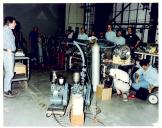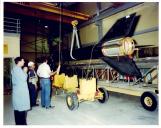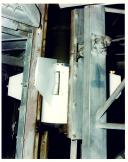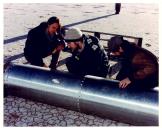The first launch has our most extensive collection of digital pictures which are grouped in time-ordered sub pages which take you through the steps in getting the payload ready for launch. Pictures are only possible through the officially sanctioned photographer at White Sands, so the pictures are grouped around major pre and post launch events:
Horizontal Integration: The horizontal integration test is the first full test with the GSFC/Wisconsin payload mated to the rest of the payload including the TM section, the parachute (OGIVE) section, and the attitude control section(ACS). The entire launch sequence is simulated with the payload still mostly separated in sections, horizontally in the vehicle assembly building.
(Click for Horizontal Integration pictures)Vehicle Assembly: Here we show the motors being assembled and mated to the payload. This is done on a section of the launch rail of the 350 launch tower. The entire rocket is then wheeled out to the launch tower and the rocket plus rail section is winched into the launch tower.

(Click for Vehicle Assembly pictues)Vertical Integration: After the rocket is installed into the launch tower, a "no-fire" count down and test of the payload systems is completed. This was done the day before the launch on December 3.

(Click for Vertical Integration pictures)Launch: Here are some great pictures of the rocket leaving the 350 tower in a hurry. The first stage burns for only 3 seconds, burning out at a mile altitude and already moving at Mach 1. The second stage burns for 30 seconds and the rocket reaches a maximum velocity of Mach 6. In our configuration we reach an altitude of 220 km.

(Click for Launch pictures)Payload Recovery: The payload lands 15 minutes after launch about 80 miles up-range in the New Mexico desert. The payload descends on a parachute impacting at about 25 miles per hour. Impact is by far the largest shock to the experiment. The experiment team and the launch team fly by army helicopter to pick up the recoverable part of the payload including the XQC experiment. The recoverable payload is then flown back to the vehicle assembly building.

(Click for Payload Recovery pictures)
This page written and maintained by F. Scott Porter (email:
Frederick.S.Porter@gsfc.nasa.gov)
Responsible NASA official: F. Scott Porter
NASA Homepage.